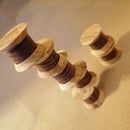Introduction: Edison Lamp in a Bell Jar
I made an Edison lamp for my cousin about 3 years ago. Since then I have wanted to make one for myself and have played around with a whole heap of different variants in my mind.
Recently I started to look at different computer aided design methods to help refine these designs.
I am very happy with the result. I had originally thought about adding a lot more in the form of details than is present in the finished work. The design refinements made as a result of being able to visualize my ideas were key to stripping back the unnecessary embellishments.
Step 1: Using SketchBookX
I found SketchbookX for tablet computers incredibly handy and intuitive for drawing out ideas to be turned.This is mainly due to the mirror tool.
The mirror tool allowed me to draw a line as a cut and see the corresponding cut appear on the opposite side.
Step 2: Google Sketchup
Google Sketchup has a whole bunch of great tools for helping out with design.
The one I use most when woodturning is the 'follow me' tool.
I tend to draw half of a design in camera front view, then change the camera to ISO and draw a circle on the mirror line.
I use the follow me tool first clicking on the item I want to make into a 3D shape and then use the circle to describe the path.
My design was refined a lot in Sketchup.
It is worth pointing out that there are other programs out there which can be used to help design. I used these two as I am more familiar with them and have access to them. You might have other preferences.
Step 3: Pick the Wood and Cut It
Pick the wood you want and cut it into a round shape.
I chose beech and mahogany.
Partly because I had them in stock and partly because I love the contrast they have with each other.
(Incidentally I really wanted the internal part to reflect the equipment used in the original Edison experiments and I thought the contrast would allow for this part to be identifiable separate from the rest of the base - this is another reason why I thought having a more simple base was a better way to go)
I marked the center on my blank which helps when working between centers.
I made sure to switch on the dust collection at this point.
Step 4: Turning the Beach to Fit Inside the Bell Jar
Locate the center and turn to a true round.
I knew that I was going to work on the end of the piece so I turned a spigot.
(A spigot is the part that the chuck can grip onto)
I then grabbed the work in the chuck and used trial and error until I found the correct dimension to fit into the bell jar.
(Interestingly this is an old hand made bell jar and it was not perfectly round meaning I had to work trial and error as a single measurement would have been inaccurate.)
Step 5: Work Out Where the Curve Should Be
I knew the curve should allow the lamp to sit above the bottom level of the bell jar but should not allow the lamp to touch the top of the jar.
I found the easiest way to work this out was to hold the lamp in the position I wanted it to be at and measure this point before transferring the measurement to the wood.
At around this time I cut a recess for the lap fitting in the wood.
Step 6: Cut That Sweet Sweet Curve Also Hollow for the Lamp Fitting
I used a bowl gouge to but the curve from the point measured earlier and hollowed for the lamp fitting.
I used trial and error to find the width of the lamp fitting.
Once this was done I put the bell jar and the fitting with wood on top of the mahogany - smiled and had a cup of tea.
Step 7: Mount the Mahogany and Work Some Woodturning Magic
Using the same method described above chuck up the mahogany work out and cut the outside diameter of the bell jar and a recess for the beech and lamp insert to fit into.
Step 8: Finnish Glue and Carve Off That Ugly Spiggot
There is a whole world of finishing products which could be used. Here I wanted a high gloss so I used sanding sealer melamine and burnishing cream; sanding between coats. The burnishing cream acts as its own sanding paper and as Elzar from Futurama would put it .. Cranks it up a notch
I carved off the spigot using sharp tools.
Step 9: Wire That Bad Boy Up
I used a 2 core wire with this lamp as well as a dimmer.
I highly recommend using a dimmer with an Edison lamp as they look better dimmed and last longer.
The wiring was completed using the manufactures instructions. I suspect most lamps are similar but its best to follow the instructions for your fitting.
Then came the moment of truth when we tested the lamp for the first time. It worked and we celebrated with a cup of tea.
Step 10: Find the Perfect Place for Your New Awesome Lamp
I'm still looking for the ideal place for my new lamp but for now it can live on the windowsill.
It gives a nice warm light which is nice to work to using sketchup and SketchBookX developing new ideas for Instructables before bed time.

Participated in the
Mind for Design













